new posts in all blogs
Viewing: Blog Posts Tagged with: Research Tools, Most Recent at Top [Help]
Results 1 - 16 of 16
How to use this Page
You are viewing the most recent posts tagged with the words: Research Tools in the JacketFlap blog reader. What is a tag? Think of a tag as a keyword or category label. Tags can both help you find posts on JacketFlap.com as well as provide an easy way for you to "remember" and classify posts for later recall. Try adding a tag yourself by clicking "Add a tag" below a post's header. Scroll down through the list of Recent Posts in the left column and click on a post title that sounds interesting. You can view all posts from a specific blog by clicking the Blog name in the right column, or you can click a 'More Posts from this Blog' link in any individual post.

By: KimberlyH,
on 2/14/2013
Blog:
OUPblog
(
Login to Add to MyJacketFlap)
JacketFlap tags:
Multimedia,
etymology,
Food & Drink,
Research Tools,
Comfort Food,
*Featured,
Arts & Leisure,
Food,
Oxford,
Valentine's Day,
oupblog,
Sweets,
Random Facts,
Online Products,
Georgia Mierswa,
Oxford Index,
croissants,
verb snack,
dutch snacken,
Add a tag
By Georgia Mierswa
This Valentine’s Day-themed tech post was supposed to be just that—a way to show that all that sexy metadata powering the Oxford Index’s sleek exterior has a sweet, romantic side, just like the rest of the population at this time of year. I’d bounce readers from a description of romantic comedies to Romeo and Juliet to the three-act opera Elegy for Young Lovers, and then change the Index’s featured homepage title to something on the art of love to complete the heart shaped, red-ribboned picture.
I didn’t do any of these things. I got distracted. As it turns out, searching the word “chocolate” (“It is not addictive like nicotine but some people, ‘chocoholics’, experience periodic cravings”) reveals a whole smorgasbord of suggested links to delectable food summaries and from my first glimpse at the makings of a meringue, I was gone—making mental notes for recipes, stomach rumbling, eyes-glazing over. Mmm glaze.
In the end, my “research” was actually quite fitting to the season. Because, really, when it comes to Valentine’s Day in the 21st century, only a handful of things are reliable and certain—and almost all of them are made with sugar.
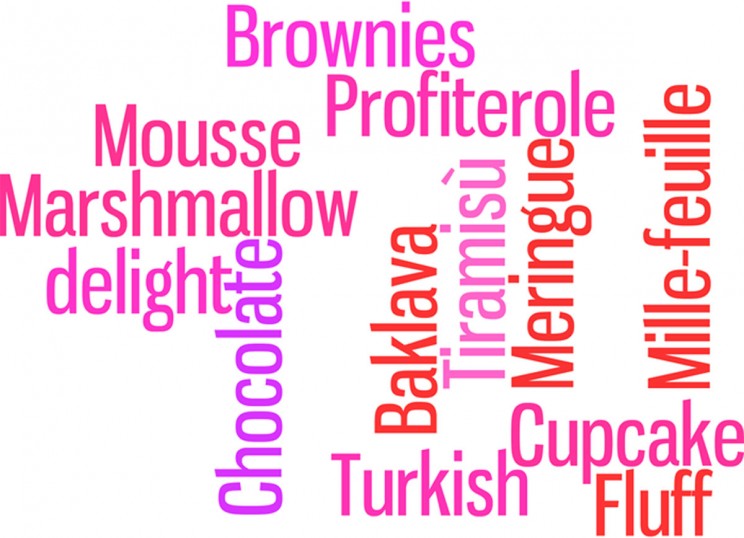
Best Mouthwatering Dessert Descriptions
Best Quote About Doughnuts…or Anything
“When Krispy Kremes are hot, they are to other doughnuts what angels are to people.”
– Humor writer Roy Blount Jr, New York Times Magazine
Best Etymology Entry
→ Snack was originally a verb, meaning ‘bite, snap’. It appears to have been borrowed, in the fourteenth century, from Middle Dutch snacken, which was probably onomatopoeic in origin, based on the sound of the snapping together of teeth… The modern verb snack, ‘eat a snack,’ mainly an American usage, is an early nineteenth-century creation.
Top 5 Favorite Random Food Facts
- Attempts to can beer before 1930 were unsuccessful because a beer can has to withstand pressures of over eighty pounds per square inch.
- Brownies are essentially the penicillin of the baking world.
- Boston is the brains behind Marshmallow Fluff.
- There is such a thing as the “Queen of Puddings” …and it sounds amazing:
→ Pudding made from custard and breadcrumbs, flavoured with lemon rind and vanilla, topped with jam or sliced fruit and meringue.
- Cupcakes are known by some as “fairy cakes”.
Best Relevancy Jump
The overview page for “cake”….
→ Plain cakes are made by rubbing the fat and sugar into the flour, with no egg; sponge cakes by whipping with or without fat; rich cakes contain dried fruit.
….leads to a surprising related link: “Greek sacrifice”
→ Vegetable products, esp. savoury cakes, were occasionally ‘sacrificed’ (the same vocabulary is used as for animal sacrifice) in lieu of animals or, much more commonly, in addition to them. But animal sacrifice was the standard type.
The Entry I Wish I Hadn’t Found:

→ Flaky crescent-shaped rolls traditionally served hot for breakfast, made from a yeast dough with a high butter content. A 50‐g croissant contains 10 g of fat of which 30% is saturated.
Best Food-Related Band Names
Best Overall Summary of What Food Is
→ Food is a form of communication that expresses the most deeply felt human experiences: love, fear, joy, anger, serenity, turmoil, passion, rage, pleasure, sorrow, happiness, and sadness.
Georgia Mierswa is a marketing assistant at Oxford University Press and reports to the Global Marketing Director for online products. She began working at OUP in September 2011.
The Oxford Index is a free search and discovery tool from Oxford University Press. It is designed to help you begin your research journey by providing a single, convenient search portal for trusted scholarship from Oxford and our partners, and then point you to the most relevant related materials — from journal articles to scholarly monographs. One search brings together top quality content and unlocks connections in a way not previously possible. Take a virtual tour of the Index to learn more.
Subscribe to the OUPblog via email or RSS.
Image credit: Croissants chauds sortis du four. Photo by Christophe Marcheux/Deelight, public domain via Wikimedia Commons
The post Comfort food appeared first on OUPblog.


By: Alice,
on 2/9/2013
Blog:
OUPblog
(
Login to Add to MyJacketFlap)
JacketFlap tags:
Dictionaries,
Multimedia,
oed,
oxford english dictionary,
odnb,
Research Tools,
Oxford Reference,
*Featured,
philip carter,
oxford dictionary of national biography,
oxford dnb,
Oxford Dictionaries Online,
Online Products,
Charlotte Buxton,
National Libraries Day,
Owen Goodyear,
Ruth Langley,
Add a tag
Ever wondered what the Latin word for owl is? Or what links Fred Perry and Ping Pong? Maybe not, but you may be able to find the answers to these questions and many more at your fingertips in your local library. As areas for ideas, inspiration, imagination and information, public libraries are stocked full of not only books but online resources to help one and all find what they need. They are places to find a great story, research your family or local history, discover the origins of words, advice about writing a CV, or help with writing an essay on topics from the First World War to feminism in Jane Austen.
Saturday 9 February 2013 is National Libraries Day in the UK, and here at Oxford we publish a variety of online resources which you can find in many local libraries. To help with the celebrations we have asked a selection of our editors to write a few words about what they feel the resource they work on offers you, why they find it so fascinating, and what it can do when put to the test! And here is what they said…
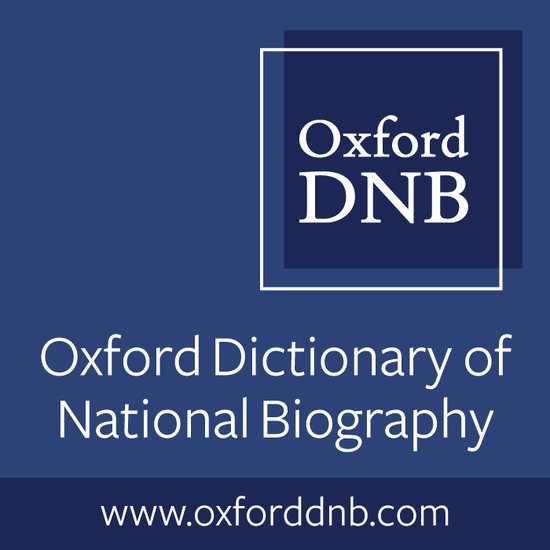 Oxford Dictionary of National Biography
Oxford Dictionary of National Biography
Philip Carter, Publication Editor, Oxford DNB
What can the Oxford Dictionary of National Biography offer librarians and their patrons? Three things, I’d say.
First, with life stories of 58,552 people who’ve shaped British history, there’s always someone new to meet: the first woman to swim the English Channel, perhaps? Or the last person convicted of witchcraft; the owner of Britain’s first curry house, the founder of the Mothers’ Union, the man who invented the football goal net. Plus 58,547 others — Julius Caesar to Jade Goody.
Second, there are new things to discover about some familiar figures. Did you know, for instance, that the cookery writer Mrs Beeton grew up in the stand of Epsom racecourse? That before tennis Fred Perry led the world at ping pong? That Roald Dahl kept 100 budgerigars and was a chocaholic, or that Dora Russell (wife of Bertrand) was the first woman to wear shorts in Britain?
Third (and perhaps most importantly) there’s the chance for some social networking — British history style. Traditionally, print dictionaries laid out their content A to Z. Online, the opportunities for new research — by local and family historians, or by teachers and students — are so much greater. Of course, the ODNB online still allows you to look up people ‘A to Z’. But it can also bring historical figures together in new ways, often for the first time — by dates, places, professions or religious affiliations. Simplest is date: for instance, it takes moments to gather the 92 men and women who were born on 9 February (National Libraries Day, 2013), including (appropriately) 15 who made their mark as writers, editors, lexicographers, and publishers.
But it’s with place searching that new discoveries really become possible, and a dictionary of the nation’s past becomes a resource for local and family history — from street level upwards. Which historical figures have connections to my county? Who once lived in my village, town, or city? Who went to my school or college? Who was baptized in this church or buried in that churchyard?
If you’d like to try for yourself, we’ve guides on using the ODNB for local history and family research, as well as bespoke pages to introduce historical figures by individual library authority (for example, Aberdeenshire or Sheffield. If you’re a librarian and would like one to promote historical figures near you, just let us know.
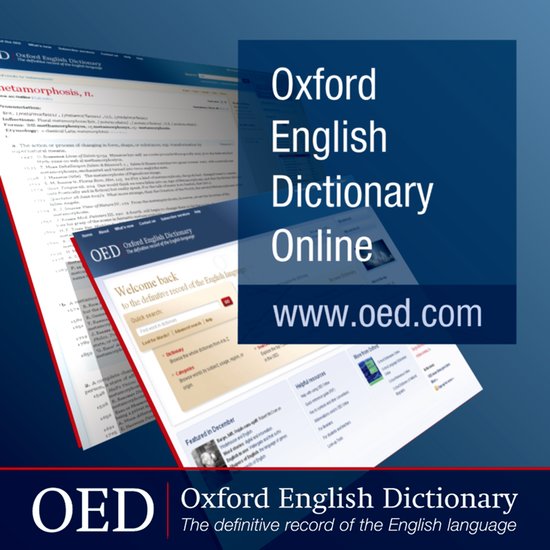 Oxford English Dictionary
Oxford English Dictionary
Owen Goodyear, Editorial Researcher
For me, what makes the OED so fascinating is the fact it is one of a kind. What sets the OED apart is the attention it pays to each word’s history. I trained in historical linguistics, and when I look at an entry, I’m always drawn to the etymology first. Take the word owl. The Latin for owl is ulula, and the early modern German huhu, rather delightfully imitating the sound of the bird. Owl is also used for varieties of pigeon — not for the sound, but its distinctive ruff — and, apparently, moths and rays, for their barn-owl-like colouring. One such type of moth is more commonly known as the garden tiger moth, which leads me to look up tiger and find the theory that its name comes from the Avestan word for sharp or arrow… then I find myself distracted by tiger as a verb, meaning to prowl about like a tiger. Pretty much what I’m doing now, in fact, following the connections from entry to entry. It’s hard to resist. Like an owl to a flame, you might say.
 Oxford Reference
Oxford Reference
Ruth Langley, Publishing Manager Reference
The new British citizenship test has been in the news lately — with commentators speculating that many people born and brought up in the UK would not be able to answer some of the questions on Britain’s history or culture. One of the wonderful things about living in Britain must surely be the access to free information found provided by the public library system, so I found myself wanting to remind all the lucky UK library users that they could find the answers they needed by logging onto Oxford Reference with their library cards. So, using a small sample of the questions featured in many newspapers, I decided to put Oxford Reference to the citizenship test — would it get the 75% necessary to prove itself well-versed in what it means to be British?
Searching for ‘Wiltshire monument’ across the 340 subject reference works on Oxford Reference, it correctly identifies Stonehenge as the multiple choice answer for the question on famous landmarks.
As I follow links from the information on Stonehenge to editorially recommended related content, I find results from OUP’s archaeology reference works which offer information on other ancient monument sites in Wiltshire like Avebury and Silbury Hill.
The admiral who died in 1805 causes no problems for our History content, and neither does the popular name for the 1801 version of the flag for the United Kingdom.
There are ten entries on St Andrew the patron Saint of Scotland, and I linger for a while to re-read his entry in one of the most colourful reference works on Oxford Reference, the Dictionary of Saints. The Dictionary of English Folklore quickly confirms that poppies are worn on Remembrance Day, and from that entry I follow a link to information about how poppies were used as a symbol of sleep or death on bedroom furniture and funerary architecture — my new fact for the day.
Other questions on the House of Commons and jury service take me to the extensive political and legal content on the site, and before long I am pleased to confirm that Oxford Reference has passed its citizenship test with flying colours.
I’ve been reminded along the way of the depth and richness of the content to be found on Oxford Reference covering all subject areas from Art to Zoology; the speed with which you can find a concise but authoritative answer to your question; the unexpected journeys you can follow as you investigate the links to related content around the site; and the pleasure in reading reference entries which have been written and vetted by experts.
 Oxford Dictionaries Online
Oxford Dictionaries Online
Charlotte Buxton, Project Editor, Oxford Dictionaries Online
As a dictionary editor, I work with words on a daily basis, but I still can’t resist turning to Oxford Dictionaries Pro when I’m out of the office. It’s not just for those moments when I need to find out what a word means (although, contrary to what my friends and family seem to believe, I don’t actually know the definition of every word, so find myself looking them up all the time). I’m a particular fan of the thesaurus: why say idiot, after all, when you could use wazzock, clodpole, or mooncalf? Most importantly, I can access the site on the move. This helps to end those tricky grammar arguments in the pub — a few taps and I can confidently declare exactly when it’s acceptable to split an infinitive, whether we should say spelled or spelt, and if data centre should be hyphenated. And thus my reputation as an expert on all matters relating to language is maintained.
And now take our UK Public Library Members Quiz for a chance to win either £50 worth of Oxford University Press books or an iPod shuffle (TM).
The majority of UK public library authorities have subscribed to numerous Oxford resources. Your public library gives you access, free of charge within the library or from home to the world’s most trusted reference works. Learn more at our library resource center and in this video:
Click here to view the embedded video.
The Oxford DNB online is freely available via public libraries across the UK. Libraries offer ‘remote access’ allowing members to log-on to the complete dictionary, for free, from home (or any other computer) twenty-four hours a day. In addition to 58,000 life stories, the ODNB offers a free, twice monthly biography podcast with over 165 life stories now available (including the lives of Alan Turing, Piltdown Man, Wallace Hartley, and Captain Scott). You can also sign up for Life of the Day, a topical biography delivered to your inbox, or follow @ODNB on Twitter for people in the news.
The Oxford English Dictionary (OED) is widely regarded as the accepted authority on the English language. It is an unsurpassed guide to the meaning, history, and pronunciation of 600,000 words — past and present — from across the English-speaking world. Most UK public libraries offer free access to OED Online from your home computer using just your library card number.
Oxford Reference is the home of Oxford’s quality reference publishing bringing together over 2 million entries, many of which are illustrated, into a single cross-searchable resource. Made up of two main collections, both fully integrated and cross-searchable in the same interface, Oxford Reference couples Oxford’s trusted A-Z reference material with an intuitive design to deliver a discoverable, up-to-date, and expanding reference resource.
Oxford Dictionaries Online is a free site offering a comprehensive current English dictionary, grammar guidance, puzzles and games, and a language blog; as well as up-to-date bilingual dictionaries in French, German, Italian, and Spanish. We also have a premium site, Oxford Dictionaries Pro, which features smart-linked dictionaries and thesauruses, audio pronunciations, example sentences, advanced search functionality, and specialist language resources for writers and editors.
Subscribe to the OUPblog via email or RSS.
The post National Libraries Day UK appeared first on OUPblog.


By: ErinF,
on 2/2/2013
Blog:
OUPblog
(
Login to Add to MyJacketFlap)
JacketFlap tags:
History,
US,
groundhog day,
Sociology,
groundhog,
Pennsylvania,
Multimedia,
jefferson,
census,
Research Tools,
imbolc,
punxsutawney phil,
Social Sciences,
*Featured,
candlemas,
punxsutawney,
social explorer,
Sydney Beveridge,
hibernating,
demography,
Online Products,
Jefferson County,
‘groundhog,
examining census,
our mapping,
Add a tag
In the United States, a German belief about the badger (applied in Switzerland to the wolf) has been transferred to the woodchuck, better known as the groundhog: on Candlemas he breaks his hibernation in order to observe the weather; if he can see his shadow he returns to his slumbers for six weeks, but if it rains he stays up and about, since winter will soon be over. This has earned Candlemas the name of ‘Groundhog Day’. In Quarryville, Lancaster County, Pa., a Slumbering Groundhog Lodge was formed, whose members, wearing silk hats and carrying canes, went out in search of a groundhog burrow; on finding one they watched its inhabitant’s conduct and reported back. Of twenty observations recorded, eight prognostications proved true, seven false, and five were indeterminate. The ritual is now carried on at Punxsutawney, Pa., where the weather prophet has been named Punxsutawney Phil. (The Oxford Companion to the Year)
By Sydney Beveridge

Every February Second, people across Pennsylvania and the world look to a famous rodent to answer the question—when will spring come?
For over 120 years, Punxsutawney Phil Soweby (Punxsutawney Phil for short) has offered his predictions, based on whether he sees his shadow (more winter) or not (an early spring).
The first official Groundhog Day celebration took place in 1887 and Phil has gone on to star in a blockbuster film, dominate the early February news cycle, and even appear on Oprah. (He also has his own Beanie Baby and his own flower.)
In addition to weather predictions, Phil also loves data, and while people think he is hibernating, he is actually conducting demographic analysis. As a Social Explorer subscriber, he used the site’s mapping and reporting tools to look at the composition of his hometown.
Click here to view the embedded video.
Punxsutawney, PA, located outside of Pittsburgh, is part of Jefferson County. Examining Census data from 1890, Phil learned that the population was 44,405 around the time of his first predictions. While the rest of the nation was becoming more urban, Jefferson County remained more rural with only one eighth of the population living in places with 2,500 people or more (compared to nearly half statewide and more than a third in the US).
Many Jefferson residents worked in the farming industry. Back then, there were 3.2 families for every farm in Jefferson County — higher than the rest of the state with 5.0 families per farm.
Less than three decades after the Civil War, the county (located in a northern state) was 99.9 percent white, which was a little higher than statewide (97.9 percent) and also higher than nationwide 87.8 percent. (The Census also noted that there was one Chinese resident of Jefferson County in 1890.)
Groundhog Day was originally called Candlemas, a day that Germans said the hibernating groundhog took a break from slumbering to check the weather. (According to the Oxford Companion to the Year.) If the creature sees its shadow, and is frightened, winter will hold on and hibernating will continue, but if not, the groundhog will stay awake and spring will come early. Back in 1890, there were 703 Germans living in Jefferson County (representing 1.6 percent of the county population and 11.3 percent of the foreign born), making Germany the fourth most common foreign born place of birth behind England, Scotland, and Austria. Groundhog Day is also said to be Celtic in its roots, so perhaps the 623 Irish residents (representing 1.4 percent of the county population and 10.1 percent of the foreign born) helped to establish the tradition in Pennsylvania.
Looking to today’s numbers, Phil was astonished to learn from the 2010 Census that Jefferson County has just 795 more people than it did 120 years ago. While Jefferson grew by 1.8 percent, the state grew by 141.6 percent and the nation grew by 393.0 percent.
2010 Census Jefferson County, PA, Population Density (click to explore)
Phil dug deeper. The 2008-10 American Community Survey data reveal that the once-prominent farming industry had shrunk considerably. (Because it is a small group, “agriculture” is now grouped with other industries including forestry, fishing and hunting, and mining.) While Jefferson residents are more likely to work in the industry than other Pennsylvanians, that share represents just 4.4 percent of the employed civilian workforce.
According to the Census, Jefferson is still predominately white (98.3 percent), while the rest of the state and nation have become somewhat more diverse (81.9 percent white in Pennsylvania and 72.4 percent nationwide). Today there are 24 Chinese residents (out of a total of 92 Asian residents).
As Phil rises from his burrow this February second, he will survey the shadows with new insight into his community and audience. To learn more about Punxsutawney Phil’s hometown burrow (and your own borough), please visit our mapping and reporting tools.
Sydney Beveridge is the Media and Content Editor for Social Explorer, where she works on the blog, curriculum materials, how-to-videos, social media outreach, presentations and strategic planning. She is a graduate of Swarthmore College and the Columbia University Graduate School of Journalism. A version of this article originally appeared on the Social Explorer blog. You can use Social Explorer’s mapping and reporting tools to investigate dreams, freedoms, and equality further.
Social Explorer is an online research tool designed to provide quick and easy access to current and historical census data and demographic information. The easy-to-use web interface lets users create maps and reports to better illustrate, analyze and understand demography and social change. From research libraries to classrooms to the front page of the New York Times, Social Explorer is helping people engage with society and science.
Subscribe to the OUPblog via email or RSS.
Subscribe to only American history articles on the OUPblog via email or RSS.
The post Burrowing into Punxsutawney Phil’s hometown data appeared first on OUPblog.


By: ErinF,
on 1/21/2013
Blog:
OUPblog
(
Login to Add to MyJacketFlap)
JacketFlap tags:
fulton,
Online Products,
fulton county,
Georgia,
History,
statistics,
US,
Sociology,
Data,
african american,
African American Studies,
census,
Martin Luther King Jr. Day,
Research Tools,
martin luther king jr,
county,
Editor's Picks,
*Featured,
social explorer,
Sydney Beveridge,
demography,
Add a tag
By Sydney Beveridge
Martin Luther King, Jr. was the legendary civil rights leader whose strong calls to end racial segregation and discrimination were central to many of the victories of the Civil Rights movement. Every January, the United States celebrates Martin Luther King, Jr. Day to honor the activist who made so many strides towards equality.
Let’s take a look at the demographics of the legendary man’s hometown then and now to see how it has (and has not) changed. King was born in 1929, so we’ll examine Census data from 1930, 1940, and the latest Census and American Community Survey data.
His boyhood home is now a historic site, situated at 450 Auburn Avenue Northeast, in Fulton County (part of Atlanta). In 1930, Fulton County had a population of 318,587 residents. A little over two thirds of the population was white (68.1 percent) and almost one third of the population was African American (31.9 percent). Today, the 920,581-member population split is nearly even at 44.5 percent white and 44.1 percent African American, according to 2010 Census data. Fulton’s population is more African American than the United States as a whole (12.6 percent), but not as as much as Atlanta (54.0 percent).
A closer look at 1940s Census data of the Atlanta area offers more detail about where the black and white populations lived. The following map shows the distribution of the black population in the Atlanta of King’s youth. Plainly, African Americans lived together, largely apart from whites.
African American Population in Fulton County, GA, and Surroundings, 1940 (click map to explore)
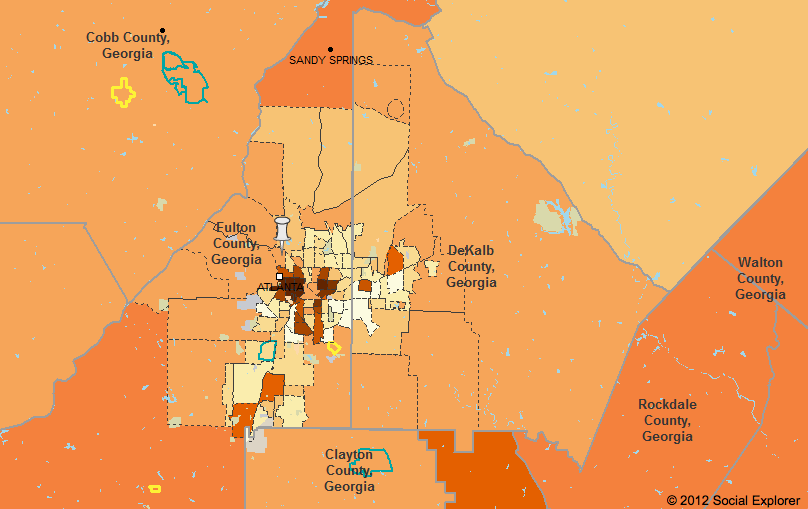
For comparison, the following map shows where the black population lives today. Now the black population has expanded in the metro area, but still seems to be quite segregated.
African American Population in Fulton County, GA, and Surroundings, 2010 (click map to explore)

Reflecting on a century after the end of slavery, King said in his famous “I Have a Dream” speech of 1963:
But one hundred years later, the Negro still is not free. One hundred years later, the life of the Negro is still sadly crippled by the manacles of segregation and the chains of discrimination. One hundred years later, the Negro lives on a lonely island of poverty in the midst of a vast ocean of material prosperity. One hundred years later, the Negro is still languished in the corners of American society and finds himself an exile in his own land. And so we’ve come here today to dramatize a shameful condition.
The quest for equal rights and freedoms made up part of a larger vision. In 1967, he spoke of aspiring for full equality at a speech at the Victory Baptist Church in Los Angeles:
Our struggle in the first phase was a struggle for decency. Now we are in the phase where there is a struggle for genuine equality. This is much more difficult. We aren’t merely struggling to integrate the lunch counter now. We’re struggling to get some money to be able to buy a hamburger or a steak when we get to the counter…
He went on to say that this would require a commitment of not only political initiative but also money: “It didn’t cost the nation one penny to integrate lunch counters. It didn’t cost the nation one penny to guarantee the right to vote. The problems that we are facing today will cost the nation billions of dollars.”
In 1968, King and other activists launched the Poor People’s Campaign, advocating for economic justice to address these imbalances in opportunity and resources. A few months later, he was assassinated.
We can look at different socioeconomic indicators to measure the country’s progress towards equality. According to 1940 Census data, more than a third (36.5 percent) of housing units in Fulton County where whites lived were owner occupied, compared to less than a seventh (14.0 percent) of the housing units where African Americans lived.
Today, home ownership increased for both groups, but the gap remains. Two thirds (66.6 percent) of white households are owner-occupied, compared to two fifths (41.7 percent) of all black households.
Home Ownership Comparison in Fulton, GA, by Race
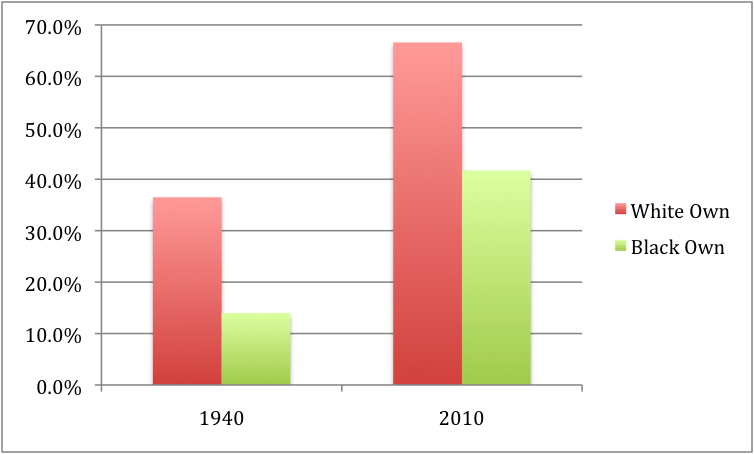
Let’s examine other measures of equality to see examples of additional gaps.
The unemployment rate is nearly twice as high among African Americans (17.9 percent) compared to among whites nationwide (9.5 percent). That gap is even more pronounced in Fulton County, where the unemployment rate for whites is 7.7 percent, while the unemployment rate for African Americans is 20.4 percent.
The percent of those living below poverty is also higher in the black community (27.2 percent) than in the white community (12.5 percent). While both groups are better off in Fulton County than the rest of the US, the poverty rate gap is even larger (8.2 percent among whites and 26.6 percent among African Americans in Fulton).
Similarly, while both groups are better educated in Fulton County compared to the rest of the US, nearly two thirds (62.4 percent) of white adults in the county have BA degrees or more, while just one quarter (25.3 percent) of the black population have the same level of education. The college attainment gap is 11.6 percentage points nationwide, but 37.1 percentage points in Fulton County.
While much progress towards freedom and equality has been made since King’s time, chronic gaps persist, even in his own backyard. The data show that 50 years after the “I Have a Dream Speech,” equal opportunity and socioeconomic status continue to lag behind equal rights.
Sydney Beveridge is the Media and Content Editor for Social Explorer, where she works on the blog, curriculum materials, how-to-videos, social media outreach, presentations and strategic planning. She is a graduate of Swarthmore College and the Columbia University Graduate School of Journalism. A version of this article originally appeared on the Social Explorer blog. You can use Social Explorer’s mapping and reporting tools to investigate dreams, freedoms, and equality further.
Social Explorer is an online research tool designed to provide quick and easy access to current and historical census data and demographic information. The easy-to-use web interface lets users create maps and reports to better illustrate, analyze and understand demography and social change. From research libraries to classrooms to the front page of the New York Times, Social Explorer is helping people engage with society and science.
Subscribe to the OUPblog via email or RSS.
Subscribe to only American history articles on the OUPblog via email or RSS.
The post Checking in on Martin Luther King, Jr.’s dream, with data appeared first on OUPblog.


By: Alice,
on 12/12/2012
Blog:
OUPblog
(
Login to Add to MyJacketFlap)
JacketFlap tags:
*Featured,
Arts & Leisure,
evergreens,
Snorri Sturluson,
iceskating,
Georgia Mierswa,
Oxford Index,
Abominable Snowman,
diamond dust,
greek friendship,
ice crystal,
Sonja Henie,
Sun Valley Serenade,
Christmas,
christmas tree,
snowman,
Multimedia,
gingerbread,
gift,
mistletoe,
snowflake,
father christmas,
Clement C. Moore,
yule,
yeti,
Research Tools,
wassail,
Add a tag
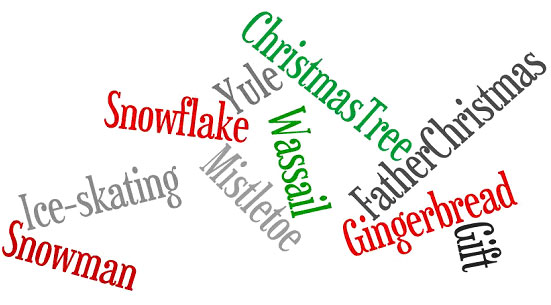
By Georgia Mierswa
Ah, the holidays. A time of leisure to eat, drink, be merry, and read up on the meaning of mistletoe in Scandinavian mythology…
Taken from the Oxford Index’s quick reference overview pages, the descriptions of the wintry-themed words above are not nearly as simplistic as you might think — and even more intriguing are the related subjects you stumble upon through the Index’s recommended links. I’ll never look at a Christmas tree the same way again.
ICE-SKATING
In its simplest form dates back many centuries, [done] with skates made out of animal bones….
→ Sonja Henie (1912 – 1969)
Norwegian figure skater. In 1923 she was Norwegian champion, between 1927 and 1936 she held ten consecutive world champion titles, and between 1928 and 1936 she won three consecutive Olympic gold medals. In 1938 she began to work in Hollywood, in, among others, the film Sun Valley Serenade (1941)…
→ Sun Valley Serenade
… Such was the popularity of the Glenn Miller Band by 1941 that it just had to appear in a film, even if the story was as light as a feather…
YULE
…The name comes from Old English gēol(a) ‘Christmas Day’; compare with Old Norse jól, originally applied to a heathen festival lasting twelve days, later to Christmas…
→ Snorri Sturluson (1178 – 1241)
Icelandic historian and poet. A leading figure of medieval Icelandic literature, he wrote the Younger Edda or Prose Edda and the Heimskringla, a history of the kings of Norway from mythical times to the year 1177…
CHRISTMAS TREE
It is generally assumed that this indisputably German custom was introduced to Britain by Queen Victoria’s husband, Prince Albert, but this is only partly true. The British royal family had had regular Christmas trees since the days of Princess Charlotte of Mecklenberg Strelitz…But it was certainly due to active promotion by Victoria and Albert that the fashion for trees spread so remarkably fast, at least among the better-off…
– a nuclear missile onboard a submarine.
– a control room or cockpit’s panel of indicator lights, green (good) and red (bad).
FATHER CHRISTMAS
– …Gives news of Christ’s birth, and urges his hearers to drink: ‘Buvez bien par toute la compagnie, Make good cheer and be right merry.’
– There were Yule Ridings in York (banned in 1572 for unruliness), where a man impersonating Yule carried cakes and meat through the street.
→ Clement C. Moore (1779 – 1863)
…Professor of Biblical learning and author of the poem popularly known as “’Twas the Night Before Christmas,” published anonymously in the Troy Sentinel (Dec. 23, 1823), widely copied, and reprinted in the author’s Poems (1844). The poem’s proper title is “A Visit from St. Nicholas.”
WASSAIL
– A festive occasion that involves drinking.
– It derives from the Old Norse greeting ves heill, ‘be in good health’.
→ Christmas
… The date was probably chosen to oppose the pagan feast of the Natalis Solis Invicti by a celebration of the birth of the ‘Sun of Righteousness’…
SNOWMAN
(1978) Raymond Briggs’s wordless picturebook uses comic‐strip techniques to depict the relationship between a boy and a snowman who comes alive in the night but melts the next day….
→ Abominable Snowman
A popular name for the yeti, recorded from the early 1920s.
→ Yeti
A large hairy creature resembling a human or bear, said to live in the highest part of the Himalayas…
…comes from Tibetan yeh-teh ‘little manlike animal’.
MISTLETOE
– Traditionally used in England to decorate houses at Christmas, when it is associated with the custom of kissing under the mistletoe.
– In Scandinavian mythology, the shaft which Loki caused the blind Hod to throw at Balder, killing him, was tipped with mistletoe, which was the only plant that could harm him.
– ‘The Mistletoe Bough’ a ballad by Thomas Bayly (1839), which recounts the story of a young bride who during a game hides herself in a chest with a spring-lock and is then trapped there; many years later her skeleton is discovered.
→ Evergreens
A high proportion of the plants important in folk customs are evergreen — a fact which can be seen either in practical or symbolic terms. Folklorists have usually highlighted the latter, suggesting that at winter festivals they represented the unconquered life-force, and at funerals immortality.
GINGERBREAD
Cake or biscuits flavoured with ginger and treacle, often baked in the shape of an animal or person, and glazed.
→ Gingerbread
The gilded scroll work and carving with which the hulls of large ships, particularly men-of-war and East Indiamen of the 15th to 18th centuries, were decorated. ‘To take some of the gilt off the gingerbread’, an act which diminishes the full enjoyment of the whole.
GIFT
– …gifts have importance for tax purposes; if they are sufficiently large they may give rise to charges under inheritance tax if given within seven years prior to death (see potentially exempt transfer).
– A gift is also a disposal for capital gains tax purposes and tax is potentially payable.
– Friends, like kin, could be called upon in any emergency; they could be expected to display solidarity, lend general support, and procure co‐operation.
– Friends were therefore supposed to be alike: a friend was ideally conceived of as one’s ‘other self’.
SNOWFLAKE
The result of the growth of ice crystals in a varied array of shapes. Very low temperatures usually result in small flakes; formation at temperatures near freezing point produces numerous crystals in large flakes.
→ Ice crystal
Frozen water composed of crystalline structures, e.g. needles, dendrites, hexagonal columns, and platelets.
→ Diamond dust
Minute ice crystals that form in extremely cold air. They are so small as to be barely visible and seem to hang suspended, twinkling as they reflect sunlight.
Georgia Mierswa is a marketing assistant at Oxford University Press and reports to the Global Marketing Director for online products. She began working at OUP in September 2011.
The Oxford Index is a free search and discovery tool from Oxford University Press. It is designed to help you begin your research journey by providing a single, convenient search portal for trusted scholarship from Oxford and our partners, and then point you to the most relevant related materials — from journal articles to scholarly monographs. One search brings together top quality content and unlocks connections in a way not previously possible. Take a virtual tour of the Index to learn more.
Subscribe to the OUPblog via email or RSS.
The post A holiday maze appeared first on OUPblog.


By: Alice,
on 9/6/2012
Blog:
OUPblog
(
Login to Add to MyJacketFlap)
JacketFlap tags:
israeli culture,
Baal Shem Tov,
David Biale,
Hasidim,
holocasut,
Oxford Bibliographies,
Oxford Bibliographies in Jewish Studies,
Simon Dubnow,
hasidism,
dubnow,
biale,
rebbes,
Religion,
Jewish studies,
World War II,
Multimedia,
jewish,
yiddish,
Jewish culture,
baal,
shem,
Research Tools,
Eastern Europe,
Humanities,
OBO,
oxford bibliographies online,
*Featured,
Add a tag
By David Biale
Two years ago, I agreed to serve as the head of an international team of nine scholars from the US, UK, Poland, and Israel who are attempting to write a history of Hasidism, the eighteenth-century Eastern European pietistic movement that remains an important force in the Orthodox Jewish world today. I was perhaps not the obvious choice for this role. Although I’ve written several articles and book chapters on Hasidism, it has not been my main area of research. But Arthur Green, one of the foremost historians of Hasidism and the person who was supposed to head the team, was unable to take on the role and I had had some success as the editor of a large compendium on Jewish and Israeli culture (Cultures of the Jews: A New History). And so, my colleagues convinced me to take on the organizational and editorial work on the project.
Surprisingly, given its long history and influence, no general history of Hasidism exists. The first attempt at such a history was published in 1931 by Simon Dubnow, the doyen of Jewish history in Russia. Dubnow had begun collecting materials for a history of Hasidism in the 1890s. However, his history covered only the first half century of the movement, ending in 1815, which is when he believed the creative period of Hasidism came to an end.
If I was going to direct this ambitious project, I needed to come up to speed on the bibliography of research over the last half century. I was familiar with the major works of the older generation of scholars such as Gershom Scholem, Joseph Weiss, Rivka Schatz-Uffenheimer, and Mendel Piekarz (to name some of the most important) as well as the younger generation, some of whom are members of our team (Ada Rapoport-Albert, Moshe Rosman, and David Assaf). Although the research community working on Hasidism is relatively small, there is still an impressive body of scholarly literature that has emerged over the last few decades.
Fortunately, at about the time I accepted the invitation to direct the Hasidism project, I was also approached by Oxford University Press to serve as Editor-in-Chief of Oxford Bibliographies in Jewish Studies. My first task was to prepare a sample bibliography. So, instead of taking on a subject whose sources were at my fingertips, I decided to put together a bibliography of Hasidism, killing the proverbial “two birds with one stone” (or, as the Jewish saying has it, “to dance at two weddings”).
What emerged from this immersion in the sources was the growing sense that our new history could significantly revise the earlier scholarship. In most of the earlier studies, as well as in Hasidism’s own self-conception, the movement was founded by the Baal Shem Tov, who died in 1760. But like the historical Jesus of Nazareth, the Baal Shem Tov (also known as the Besht) wrote little and probably had no intention of founding a movement. It was only later in the eighteenth century that scattered charismatic leaders (known as rebbes in Yiddish, or zaddikim in Hebrew) began to be seen (and to see themselves) as a coherent movement. But since the Hasidim organized themselves as devoted followers of specific individuals, the movement had no central core. Each of these rebbes had his own philosophy and style of leadership, so that one should speak of Hasidism in the plural.
The nineteenth century, far from a time of stagnation, as Dubnow thought, now appears to have been the golden age of Hasidism. While it is questionable whether the majority of Eastern Jews were Hasidim, the movement spread rapidly and became even more active in areas of Poland and Galicia than in the provinces of Ukraine where it originated. In the twentieth century, Hasidism underwent a sharp decline as a result of the Bolshevik Revolution, the rise of secular Jewish politics in Poland, and the devastation of the Holocaust (see The Holocaust in Poland). Following World War II, the movement rose from the ashes in North America and Israel, in exile, as it were, from its Eastern European homeland. Today, there may be as many as three-quarters of a million Hasidim (out of 13 million Jews worldwide). But a movement that presents itself and is often seen by others as devout guardians of tradition is, in reality, something new, a product of modernity no less than Jewish secularism.
David Biale, Editor in Chief of Oxford Bibliographies in Jewish Studies, is the Emanuel Ringelblum Professor of Jewish History in the department of history of University of California Davis. He is the editor of Cultures of the Jews: A New History (Schocken Books, 2002) and the author of Blood and Belief: The Circulating of a Symbol Between Jews and Christians (University of California Press, 2008).
Developed cooperatively with scholars and librarians worldwide, Oxford Bibliographies offers exclusive, authoritative research guides. Combining the best features of an annotated bibliography and a high-level encyclopedia, this cutting-edge resource guides researchers to the best available scholarship across a wide variety of subjects.
Subscribe to the OUPblog via email or RSS.
Subscribe to only religion articles on the OUPblog via email or RSS.


By: ReaganK,
on 9/1/2012
Blog:
OUPblog
(
Login to Add to MyJacketFlap)
JacketFlap tags:
Literature,
Multimedia,
chaucer,
Walter William Skeat,
Research Tools,
Canterbury Tales,
Humanities,
*Featured,
Oxford Scholarly Editions Online,
Online Products,
Christopher Cannon,
Edith Rickert,
Ellesmere,
Jill Mann,
John Manly,
OSEO,
recension,
Riverside Chaucer,
rickert,
manly,
Add a tag
By Christopher Cannon
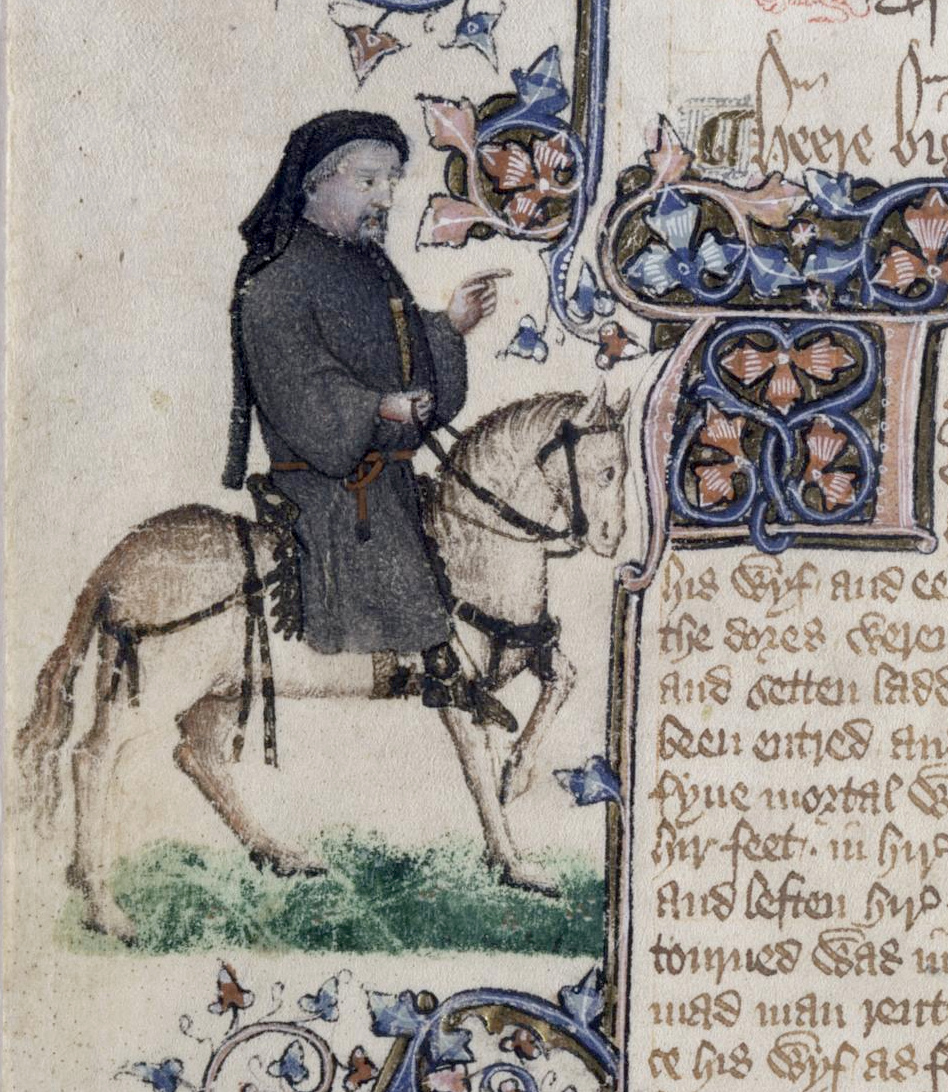 The editing of Chaucer’s Canterbury Tales in the form in which we now read it took many decades of work by a number of different scholars, but there is as yet no readily available edition that takes account of all the different versions in which the Canterbury Tales survives. Some of this is purely pragmatic. There are over 80 surviving manuscripts from before 1500 containing all or some parts of the Tales (55 of these are complete texts or were meant to be). The great Oxford edition of the nineteenth century, by Walter William Skeat, relies mostly on a single manuscript (‘Ellesmere’) with corrections from only six other texts. The edition in which most people have read the Tales in recent decades, the Riverside Chaucer (also printed in the UK by Oxford), also relies on Ellesmere, although it consults many more manuscripts than six to establish its base text. This is also Jill Mann’s practice in the recent Penguin edition of the Tales. But what if someone wanted to edit Chaucer from all the manuscripts, accounting carefully for all the variations? What if a student simply wanted to get some sense of what sorts of variation were possible in a manuscript culture, where every copy of a text was different because every such copy had to be hand-written?
The editing of Chaucer’s Canterbury Tales in the form in which we now read it took many decades of work by a number of different scholars, but there is as yet no readily available edition that takes account of all the different versions in which the Canterbury Tales survives. Some of this is purely pragmatic. There are over 80 surviving manuscripts from before 1500 containing all or some parts of the Tales (55 of these are complete texts or were meant to be). The great Oxford edition of the nineteenth century, by Walter William Skeat, relies mostly on a single manuscript (‘Ellesmere’) with corrections from only six other texts. The edition in which most people have read the Tales in recent decades, the Riverside Chaucer (also printed in the UK by Oxford), also relies on Ellesmere, although it consults many more manuscripts than six to establish its base text. This is also Jill Mann’s practice in the recent Penguin edition of the Tales. But what if someone wanted to edit Chaucer from all the manuscripts, accounting carefully for all the variations? What if a student simply wanted to get some sense of what sorts of variation were possible in a manuscript culture, where every copy of a text was different because every such copy had to be hand-written?
Since 1940 such curiosity could be satisfied in John Manly and Edith Rickert’s seven-volume Text of the Canterbury Tales ‘on the basis of all the known manuscripts’. But this edition has been under a cloud ever since it first appeared because it used all these manuscripts to try to work back to the ‘original’ text of the Tales (the process is called ‘recension’), and accidentally demonstrated in the process that this is not possible. There probably never was such an original, not least because Chaucer never finished the Tales, and even if there had been, there are too many small errors in the extant manuscripts to eliminate all of them. A more practical obstacle for any curiosity about the nature of this variation, however, is the form in which Manly and Rickert had to present the information they assembled. Take just the 10th line of the portrait of the ‘clerk of Oxford’ in the General Prologue of the Tales, for example, in which the narrator tells us his library consisted of
Twenty bookes clad in black or reed
This line can be found on p. 14 of volume 3 of this edition, and if one looks down to the bottom of the page a set variants is displayed in this way:
or] and Ha4 –a –b* (-) cd* (-) Bo2 En3 Fi PS Py Ra3 Tc1
‘Or’ identifies the word for which variants exist; the close bracket marks the start of those variants; ‘and’ is the word that sometimes occurs instead of ‘or’; and the alphanumeric soup that follows ‘and’ consists of the identifiers (‘sigla’) for the manuscripts in which this variant can be found. As it happens, this list is a simplified account of the variants for this line in all of the manuscripts that Manly and Rickert consulted — what it seemed necessary to mention in order to justify the text they printed. The full variation of these variants is printed in the ‘corpus of variants’ that fills the last three volumes of this edition, and the entry for the line I have just quoted (on page 24 of volume 5) is as follows:
bookes] goode b. Ps2 | clad] clothed Ha4 Ii; clodde Ht | blak] whit Cx1 Fi N1 Py S12 Tc1 | or ] and a Bo2 c Cx1 D1 Fi En3 Ha2 Ha4 Ht Ii Ld1 Mg Mm N1 Ps Py ra3 Ry2 Se Tc1 | reed] in r. Dd Ht Ry1
This list shows that some manuscripts say ‘goode bookes’ rather than only ‘bookes’, that some say ‘clodde’ or ‘clothed’ rather than ‘clad’, and that some say ‘white’ rather than ‘black’. None of these differences is hugely consequential (though the last of them is certainly interesting), but the combination of triviality (to meaning) and complexity (of form) will itself be enough to explain why Manly and Rickert place them in separate volumes, or why an editor such as Skeat would narrow the range of manuscripts from which he chose his readings to 7, or why he too would limit the variants he printed to no more than the readings he corrected (few enough to fit in a narrow column at the bottom of each page). In fact, for the line on the clerk’s books, there is nothing at all at the foot of Skeat’s page, although the line printed is slightly different from Manly and Rickert’s:
Twenty bokes, clad in blak or reed
The difference consists of the spelling ‘bokes’ in place of ‘bookes’, and the insertion (this would have been Skeat’s editorial decision) of a comma. More important than the nature or size (or consequence) of this difference, however, is the way that the print technology that has determined how we read Chaucer for so long must always tend toward Skeat’s simplicity. Mann’s Penguin edition, the most user-friendly we now have — and therefore destined to be the most read in future years — does not include variants at all. The Riverside Chaucer includes some variants in its ‘Textual Notes’ but it moves all of these to the back of the book. Complicate things as much as Manly and Rickert did with all the variants, and no one will read your text.
Online editions open out new possibilities for marrying simplicity to completeness. One can imagine a hypertext edition in which all the variants associated with a particular word, phrase, or line, would simply appear as a cursor passed over the text (much as the contents of a footnote will appear in a bubble when the cursor moves across the reference in a text written in Word). The paradox seems stark: only when the words of the text are lifted entirely away from any page can the complexity of the page be fully preserved and disseminated. And yet it is not a paradox if we think of such a hypertext as finally overcoming the limits of print technology. No longer shackled by the limits of mechanical reproduction, the digital age gives us a text that, precisely because it lacks physical form is supple enough to represent the complexity of that form.
Such a hypertext is not yet with us because entering the variants in the marked-up form that would make them available in this way is itself a huge undertaking (digital technology is never more powerful than the information human labor can provide for it). But an online edition such as Oxford’s is already sufficient to the task of making the complex simple in all the ways that a medieval text with many variants requires. If books must separate variants from the text of the Tales in precise proportion to their detail (include many and they must be placed at the back of the book; include all of them and you need several more books), but simply give yourself the virtual page in which an infinite amount of information may un-scroll in one column while the text sits happily, unmoved, in another, and all the variants of a text can accompany every word and phrase and line of that text at all times. Such an edition can also put the complexity of these variants in the hand of everyone — student and scholar alike — who has a computer and an internet connection.
Many libraries own neither Manly-Rickert nor Skeat. And even the copyright library in which I write these remarks, the Cambridge University Library, requires that the volumes of Manly-Rickert be fetched to its ‘West Room’, but keeps Skeat in its Rare Books Room (because it was published before 1900). To bring Manly-Rickert’s variants to Skeat’s text they must be couriered by a member of staff (a reader cannot transport them from West to Rare Books Room himself). Since neither set of volumes circulates I could not bring them home to compare with my own copies of the Riverside and Mann’s Penguin edition. These common editions should have been available on the open shelves (and I could have found them there and brought them to the Rare Books room myself) but, as it happened, on the day I was gathering these volumes together, the Penguin edition of the Tales was checked out.
None of these movements is anything more than tedious, and careful scholarship moves greater mountains of inconvenience very day. And yet these are obstacles that might well defeat the undergraduate or post-graduate who simply wanted to explore what variation might exist in the text of the Tales. And a scholar focused on the variants in the text of the Tales might more easily go beyond those variants (to thoughts about the patterns they display; to theories about the nature or reliability of the edited text itself) if it was easier to consult them. What everybody who reads the Canterbury Tales has lacked up until this point, in other words, is a way of accessing all the richness of the material form in which the Tales survives as a constant and necessary concomitant of a readable text. The representational power of digital technology enriches the works we have long known and loved by just such elaborations.
Christopher Cannon is a Professor of English at New York University and member of the Oxford Scholarly Editions Online editorial board. He teaches Middle English literature at New York University. He took his BA, MA and PhD at Harvard University, and then taught, successively, at UCLA, Oxford, and Cambridge. His PhD dissertation and first book, The Making of Chaucer’s English (1998) analyzed the origins of Chaucer’s vocabulary and style using an extensive database and purpose-built software to demonstrate that Chaucer owed much more to earlier English writers than had been recognized before. His second book, on early Middle English, The Grounds of English Literature (2004), developed these discoveries by means of a new theory of literary form. Most recently he has written a cultural history of Middle English.
Oxford Scholarly Editions Online is coming soon. To discover more about it, view this series of videos about the launch of the project or read a series of blog posts on the OUPblog.
Subscribe to the OUPblog via email or RSS.
Subscribe to only humanities articles on the OUPblog via email or RSS.
Image credit: Image of Chaucer as a pilgrim from Ellesmere Manuscript in the Huntington Library in San Marino, California. The manuscript is an early publishing of the Canterbury Tales. Source: Wikimedia Commons.


By: Alice,
on 3/16/2012
Blog:
OUPblog
(
Login to Add to MyJacketFlap)
JacketFlap tags:
Minnesota,
Geography,
Finland,
Multimedia,
Wisconsin,
grasshopper,
Finnish,
Research Tools,
Social Sciences,
*Featured,
patrick’s,
social explorer,
Sydney Beveridge,
Finns,
St. Urho’s Day,
urho’s,
“heinäsirkka,
heinäsirkka,
urho,
Add a tag
By Sydney Beveridge
 While Irish eyes are smiling on St. Patrick’s Day, many Finns are already celebrating St. Urho’s Day. The holiday was first celebrated in Minnesota on March 16th, which happens to be just before St. Patrick’s Day.
While Irish eyes are smiling on St. Patrick’s Day, many Finns are already celebrating St. Urho’s Day. The holiday was first celebrated in Minnesota on March 16th, which happens to be just before St. Patrick’s Day.
It honors the legendary Urho, the patron saint of vineyard workers. As the story goes, he saved the grape crop from a grasshopper infestation with his horrible breath as he yelled, “Heinäsirkka, heinäsirkka, mene täältä hiiteen!” (Grasshopper, grasshopper, go away!)
Soon after the first St. Urho’s Day was celebrated, the 1960 census reported that there were 240,827 people in the US born in Finland, representing 0.1 percent of the total population.
Over 15 percent of them resided in Minnesota, where St. Urho celebrations first originated.
According to the 2010 American Community Survey, there are now 647,697 residents of Finnish ancestry, making up about 0.2 percent of the total population.
Some St. Urho’s Day revelers dress up as grasshoppers and grapes to celebrate. As you can see, Finns are especially concentrated in northern Minnesota and Wisconsin. Explore the map to see where you should plan your next St. Urho’s Day outing, or if you are a grasshopper, where to avoid.
Map of Finnish Residents in the US (2006-10 Census)

Happy St. Urho’s Day from Social Explorer!
Sydney Beveridge is the Media and Content Editor for Social Explorer, where she works on the blog, curriculum materials, how-to-videos, social media outreach, presentations and strategic planning. She is a graduate of Swarthmore College and the Columbia University Graduate School of Journalism.
Subscribe to the OUPblog via email or RSS.


By: Lauren,
on 10/6/2011
Blog:
OUPblog
(
Login to Add to MyJacketFlap)
JacketFlap tags:
Research Tools,
acquisition,
UPSO,
*Featured,
digital strategy,
discoverability,
lenny allen,
oxford scholarship,
university press scholarship online,
presses,
awake–dreaming,
scholarly,
monograph,
Technology,
XML,
platform,
tagging,
metadata,
OSO,
Add a tag
By Lenny Allen
The title of the classic Philip K. Dick story asks whether androids dream of electric sheep. I don’t know the answer to that particular question, but I do know that we’re all–at this very moment, asleep or awake–dreaming of a digital monograph platform that is financially viable, intuitive, sustainable from the perspective of a rapidly shifting market environment, and adaptable enough to be able to meet both the short and long-term needs of scholarly research at all levels as well as the development of new business and acquisition models.


By: Lauren,
on 9/20/2011
Blog:
OUPblog
(
Login to Add to MyJacketFlap)
JacketFlap tags:
gender,
back to school,
census,
Research Tools,
explorer,
catching,
genders,
*Featured,
social explorer,
Sydney Beveridge,
college degree,
attainment,
degrees,
high school degree,
enrolled,
censuses,
Education,
Add a tag
By Sydney Beveridge
Some of the earliest detailed census data on education came from 1850 when the census reported information about school attendance. For many decades, the census focused on literacy rates, which we discussed in part two of the back to school series.
By the mid-1900s, data on educational attainment emerged (elementary school, high school, college, etc.), adding new insight into education


By: Lauren,
on 8/30/2011
Blog:
OUPblog
(
Login to Add to MyJacketFlap)
JacketFlap tags:
*Featured,
Sociology,
Education,
employment,
educational,
unemployment,
lesson,
Research Tools,
salary,
earnings,
ethnicity,
explorer,
wage gap,
Images & Slideshows,
social explorer,
Sydney Beveridge,
attainment,
degrees,
Add a tag
By Sydney Beveridge, Social Explorer
With the new school year approaching, Social Explorer is taking a closer look at education data today and over the years.
The most recent available data (from the 2009 American Community Survey) reveal education levels and distinctions among groups, as well as the correlations between educational attainment, income and employment.


By: Kirsty,
on 5/26/2011
Blog:
OUPblog
(
Login to Add to MyJacketFlap)
JacketFlap tags:
owen rhoscomyl,
oxford dictionary of national biography,
oxford dnb,
rose davies,
two—staniforth,
History,
Biography,
Reference,
UK,
Research Tools,
*Featured,
arthur linton,
Bywgraffiadur Cymreig,
chris williams,
cymru,
dan davies,
godfrey charles morgan,
jimmy michael,
Wales,
welsh,
odnb,
Add a tag
By Chris Williams
Friedrich Engels once dismissed the Welsh, amongst others, as a ‘non-historic’ people, destined to be absorbed into the grander story of the English nation-state. Much of the subsequent history of Wales has proven him wrong, at least on that point, but carving out a distinct niche for the written history has always been a challenge.
Welsh historians have traditionally hovered between either going their own way (we’ve had a respectable journal—The Welsh History Review—for more than half a century, and a monograph series—Studies in Welsh History—for over thirty years) and running the risk of ghettoization, or trying to gain an audience for their work in British or European contexts and occasionally being patronized as ‘parochial’.
Historical biography has presented similar difficulties. To many Welsh scholars the original, Victorian edition of the Dictionary of National Biography reeked of the English establishment, and given that most were either socialists or Welsh nationalists (or both) this was not something to be welcomed.
The rival Bywgraffiadur Cymreig/Dictionary of Welsh Biography (first published in 1953) was a never fully satisfactory alternative—only once being brought up to date (from 1940 to 1970, in 2001). Its great strengths were its entries on male preachers and littérateurs. Women, trade unionists, even businessmen, were few and far between. Aneurin Bevan is alleged to have stated that ‘biography is fiction’ and, allegedly or not, many agreed with him.
More recently, however, the Oxford Dictionary of National Biography has been offering biographers manqués opportunities to refine their craft, and has aimed to broaden the remit of the old DNB, not least through embracing the explosion of interest in social and gender history.
The latest Oxford DNB update looks to Wales with the addition of new entries on 45 men and women who’ve shaped modern Welsh history, and who join more than 3200 others already in the dictionary with a close association with Wales. As an advisory editor for this update I was excited to help frame the selection of these 45 individuals and fascinated to discuss, with ODNB staff and my fellow adviser Professor Gareth Williams (no relation—there are a lot of us Williamses) who should (or should not) go in to the new edition. It was a horizon-expanding experience—I guess a good dozen of those who have been included were people I was but dimly aware of, if at all.
I wrote two entries myself, on the cartoonist J. M. Staniforth (1863-1921) and on the military hero, landowner, and politician Godfrey Charles Morgan, Viscount Tredegar (1831-1913). In the process I discovered a connection between the two—Staniforth had illustrated a volume on The Wit and Wisdom of Lord Tredegar (the Encyclopedia of Wales suggests, rather unfairly, that this proved Tredegar ‘was not over-endowed with either’).
But much of my role consisted of reading and reviewing the entries supplied by others. In doing that it became evident that the picture of Welsh society being prosopographically generated was much more varied than the conventional stereotypes of politicians, Nonconformists, and rugby heroes.
Politicians there are, of course, but the archetypal career trajectory of Ness Edwards (1897-1968: miner, trade union leader, Labour MP, and minister under Clement Attlee) can be counterbalanced

By: Michelle,
on 4/22/2011
Blog:
OUPblog
(
Login to Add to MyJacketFlap)
JacketFlap tags:
Art & Architecture,
Images & Slideshows,
casely,
*Featured,
wedding,
UK,
celebrity,
Multimedia,
dress,
hayford,
kate,
liberty,
Research Tools,
wedding dress,
maker,
prince william,
royal wedding,
kate middleton,
berg fashion library,
fashion friday,
Add a tag
By Justyna Zajac and Michelle Rafferty
The Royal Wedding is days away and every detail – from the regal breakfast to the honeymoon – is under scrutiny. But we think there’s only one thing that really matters: the dress. So, we’ve taken it upon ourselves to select a few options for Miss Kate. In the off-chance she turns us down, we’ve paired up other celebrity brides-to-be with these charming gowns. Pictures and historical facts courtesy of The Berg Fashion Library.
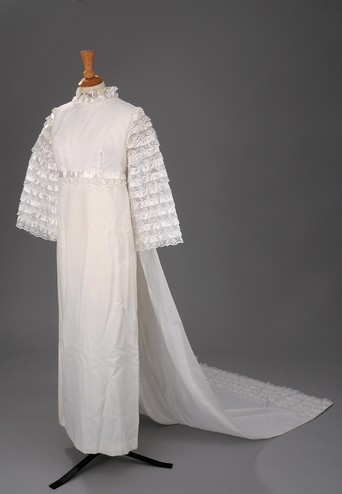
Artist/Maker: Emenson, ca. 1970
We hope that “Kate the Great” soars in her new role as princess, and she literally can, with
these wing-like sleeves and a 188 cm long cape, eh train, 188 cm long train.
Back-up celebrity: If Kate vetos, we recommend this one for Natalie
Portman (she was after all, a much better white swan).

Artist/Maker: Created for the Corvin Department Store in 1943 (Hungary)
We think the white georgette embroidered apron is a nice way for Kate to let the
people of England know she will never forget her “humble” roots.
Back-up celebrity: Jessica Simpson (we hear she’s on the lookout for a
low-cut dress, which for the 40s this was).
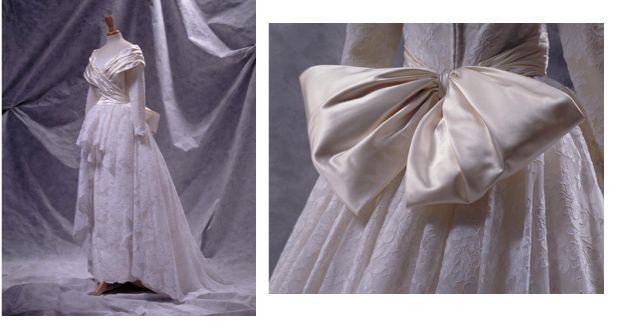
Artist/Maker: Victor Edelstein, 1987 (Great Britain)
Newsweek recently stated: “In a world gone to hell – thank God, a wedding.”
We couldn’t agree more. This a gift to the world, so lets put a bow on it (see: enormous bow above).
Back-up celebrity: Amy Adams (lest we forget her princess flair).

0 Comments on 5 dresses for Kate as of 1/1/1900
By Mark C. Carnes
General Editor, ANB
The 150th anniversary of the Civil War will be commemorated in the usual ways. But a truly unique approach is provided by the online—and thus searchable—version of the American National Biography, a 27-million word collection of biographical essays on some 18,731 deceased Americans who played a significant role in the nation’s past.
Readers can of course acquire an understanding of the major figures, perhaps beginning with James M. McPherson’s long essays on Abraham Lincoln and Ulysses S. Grant and Russell F. Weigley’s on Robert E. Lee. But there are many hundreds of essays on figures associated with all aspects of the war.
Those interested in a particular battle, for instance, can use the ANB online. A full-text search of articles for “Gettysburg” yields 253 separate biographical essays, the great majority on soldiers who fought there.
But this search also unearths many new gems of information, such as the fact that William Corby, a Roman Catholic priest assigned to New York’s Irish Brigade, stood upon a boulder, raised his right hand, and offered a general absolution for the combatants just before the armies converged.
Women, too, surface in this search. Eliza Farnham, the author of Life in Prairie Land (1846) and a crusader for prison reform and women’s causes, tended the wounded at Gettysburg, where she contracted tuberculosis; she died the next year at age 49. Eliza Turner, an early feminist, abolitionist, and poet, also cared for the wounded at Gettysburg. She later wrote an important woman suffrage tract. Elizabeth Keckley, a former slave who became the dressmaker, dresser, and confidante of Mary Lincoln, attended the Gettysburg commemoration with the first lady.
Scholars—and history buffs—can look at the Civil War from another fresh perspective through ANB searches by geographical location. For example a full-text search for “Frankfort, Kentucky,” limited to subjects between 1800 and 1840, generates nearly three dozen responses. Among the many interesting essays are those on the following:
Leonidas Polk, a graduate of West Point who became an Episcopal bishop and the owner of a Louisiana sugar plantation. At the outset of the Civil War he volunteered to command Confederate forces and Jefferson Davis named him major general for the upper Mississippi region. In September 1862, during an offensive to seize Kentucky, Polk disobeyed an order to attack, forcing Braxton Bragg to abandon Frankfort.
John Marshall Harlan, who raised and commanded the Tenth Kentucky Volunteers. His efforts helped keep Kentucky in the Union, winning for him the support of national Republicans; in 1877 President Rutherford B. Hayes nominated Harlan to the Supreme Court.
Luke Pryor Blackburn, a physician who became governor of Kentucky. He had served as the public health officer for Natchez, Mississippi, during the yellow fever epidemics of 1848 and 1854. During the Civil War the Confederacy sent Blackburn to Canada to collect arms and hospital supplies to be shipped through the Union blockade. In Canada Blackburn devised a scheme to spread yellow fever through Northern cities. To that end he traveled to Bermuda during the epidemic of 1864, collected the bedding of dying fever victims, and shipped it in trunks to cities in the North. (The plan failed: Blackburn did not understand that mosquitoes were the agent of transmission of yellow fever.) Charged with conspiracy to commit murder, Blackburn was acquitted by a Canadian court. He returned to the United States, settled in Kentucky, won a measure










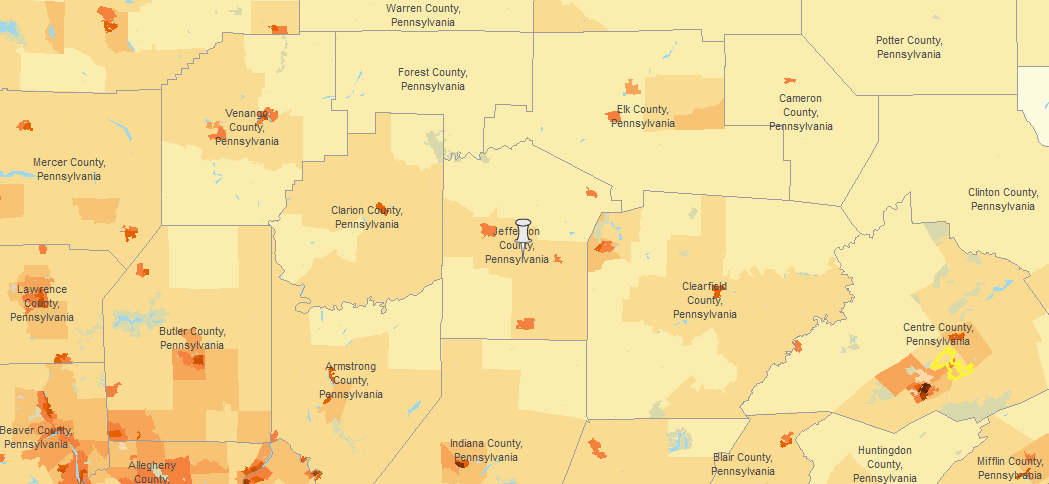





 While Irish eyes are smiling on St. Patrick’s Day, many Finns are already celebrating St. Urho’s Day. The holiday was first celebrated in Minnesota on March 16th, which happens to be just before St. Patrick’s Day.
While Irish eyes are smiling on St. Patrick’s Day, many Finns are already celebrating St. Urho’s Day. The holiday was first celebrated in Minnesota on March 16th, which happens to be just before St. Patrick’s Day.



